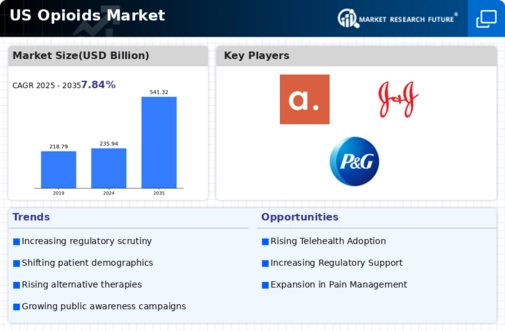The competitive landscape of the US Opioids Market is characterized by a complex interplay of regulatory pressures, emerging therapeutic needs, and evolving consumer perceptions of pain management. With the increasing scrutiny on opioid prescriptions amid the opioid crisis, companies operating within this sphere are compelled to adapt their strategies to maintain their market share while prioritizing patient safety.
Market players have been compelled to innovate by focusing on the development of newer formulations, abuse-deterrent technologies, and alternative therapies that cater to both chronic and acute pain management. Furthermore, collaborations and partnerships within the pharmaceutical industry have become increasingly vital as companies seek to leverage their strengths and enhance their competitive positioning in an environment marked by high competition and rapid changes.
AstraZeneca
AstraZeneca has made significant strides in the US Opioids Market through its impactful approach to pain management. The company has focused on developing innovative therapies that address unmet medical needs while ensuring compliance with evolving regulatory standards. AstraZeneca's strength lies in its strong research and development capabilities, allowing for the continuous introduction of new products that enhance its portfolio in the opioids segment.
Additionally, its existing relationships with healthcare providers and a deep understanding of market dynamics have enabled AstraZeneca to establish a robust presence in the pain management sector. By maintaining a patient-centered focus and emphasizing responsible prescribing practices, AstraZeneca aims to contribute positively to pain alleviation while navigating the complexities of the opioid landscape.
BristolMyers Squibb
BristolMyers Squibb has positioned itself as a formidable player in the US Opioids Market by offering a range of products that cater to various pain management needs. The company develops and markets opioids that are recognized for their efficacy in treating severe pain, thus contributing to BristolMyers Squibb's strong reputation within the field.
Their portfolio is bolstered by their commitment to research and innovation, which has led to the introduction of advanced formulations and delivery methods. BristolMyers Squibb's strengths also include strategic mergers and acquisitions that have allowed for expansion in its product offerings and capabilities in the therapeutics space.
The company's effective marketing strategies, combined with its emphasis on safety and efficacy, reinforce its market position even in a challenging regulatory environment. As the opioid crisis poses ongoing challenges to the industry, BristolMyers Squibb continues to navigate this landscape while prioritizing the needs of patients and healthcare providers.













